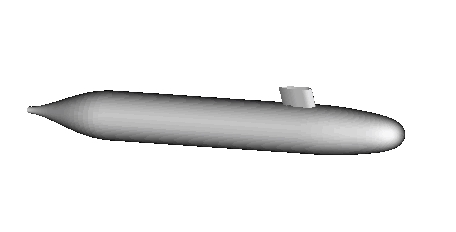![]()
DEPARTMENT OF AEROSPACE AND OCEAN ENGINEERINGUNSTEADY SKIN-FRICTION MEASUREMENTS ON A MANEUVERING DARPA2 SUBOFF MODEL |
![]()
UNSTEADY SKIN-FRICTION MEASUREMENTS ON A MANEUVERING DARPA2 SUBOFF MODEL
Serhat Hosder, June, 2001
(ABSTRACT)
Steady and unsteady flow over a generic Suboff submarine model is studied. The skin-friction magnitudes are measured by using hot-film sensors each connected to a constant temperature anemometer. The local minima in the skin-friction magnitudes are used to obtain the separation locations. Steady static pressure measurements on the model surface are performed at 10° and 20° angles of attack. Steady and unsteady results are presented for two model configurations: barebody and sail-on-side case. The dynamic plunge-pitch-roll model mount (DyPPiR) is used to simulate the pitchup maneuvers. The pitchup maneuver is a linear ramp from 1° to 27° in 0.33 seconds. All the tests are conducted at ReL=5,500,000 with a nominal wind tunnel speed of 42.7±1 m/s. Steady results show that the flow structure on the leeward side of the barebody can be characterized by the crossflow separation. In the sail-on-side case, the separation pattern of the non-sail region follow the barebody separation trend closely. The flow on the sail side is strongly affected by the presence of the sail and the separation pattern is different from the crossflow separation. The flow in the vicinity of the sail-body junction is dominated by the horseshoe type separation. Unsteady results of the barebody and the non-sail region of the sail-on-side case show significant time lags between unsteady and steady crossflow separation locations. These effects produce the difference in separation topology between the unsteady and steady flowfields. A first-order time lag model approximates the unsteady separation locations reasonably well and time lags are obtained by fitting the model equation with the experimental data. The unsteady separation pattern of the sail side does not follow the quasi-steady data with a time lag and the unsteady separation structure is different from the unsteady crossflow separation topology observed for the barebody and the non-sail region of the sail-on-side case
RELATED
PUBLICATIONS
(Contain analysis of this data)
|
|
[1] Hosder, S., Unsteady
Skin-Friction Measurements On a Maneuvering DARPA2 Suboff Model, M.S.
Thesis, Department. of Aerospace and Ocean Engineering, Virginia Polytechnic
Instate and State University, |
|
|
[2] Hosder, S., and Simpson, R. L., Unsteady Turbulent Skin-Friction and Separation Location Measurements On A Maneuvering Undersea Vehicle, AIAA Paper 2001-1000, 39th AIAA Aerospace Sciences Meeting and Exhibit, Reno, Nevada, January 2001. |
DATA AVAILABLE FOR DOWNLOADING
The test conditions and the model configurations of the DARPA-2 skin-friction experiments are given in chapter 3 of ref. [1]. The reduced data files can be reached from the below links. All the data files are in text format. More information about the format of the data files is given in each of the links below.
Steady Cf (Skin-friction) Data:
Steady Cp (Pressure) Data:
Unsteady Cf Data:
For more information, e-mail Professor Roger L. Simpson or Serhat Hosder
Send comments and
suggestions to
shosder@vt.edu
Copyright © 2004 AOE Dept.,

